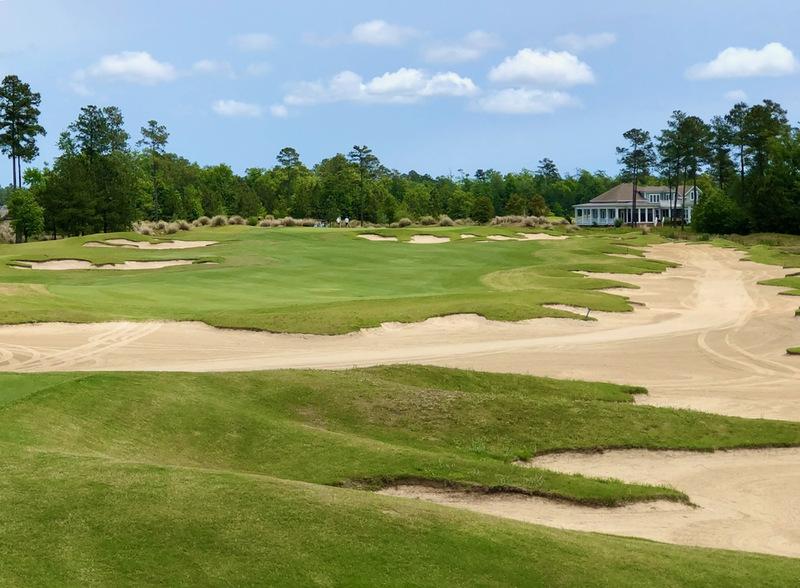In March, the National Association of Realtors settled a class-action lawsuit brought by a group of Missouri homeowners. After a court slapped the NAR with a $1.8 billion judgment – not a typo -- the trade organization settled for $418 million. The agreement is expected to be validated by the courts in July, after which the relationships among the real estate industry and buyers and sellers will change forever; just how much will be determined in the coming months and evolve over years.Next week, my newsletter – Home On The Course – will publish a deep dive on what the settlement means for buyers, sellers, real estate agencies and the agents who represent both buyers and sellers. (Subscribe to Home On The Course for free here.)
In the meantime, if you are considering purchasing a brand new home inside or outside a golf community, the changes developers and builders are considering in the wake of the settlement may help you in your search and negotiations. Of course, most homes bought and sold in the U.S. are not new; I will address the effects on those in the newsletter.
First, here are the sea changes the NAR agreed to that will change how real estate buying and selling will be conducted – although the magnitude of the changes will not be obvious until after a court confirms the settlement in July. The two major changes are that the seller’s commission rate – typically 6% in most locations – can no longer include an even split with the buyer’s agency (although most listing agencies will try to convince sellers that paying the buy side as much as 3% of the total sale price of a property will help spur a quick and full-price sale). Also, the local multiple listing services (MLS) will no longer be permitted to publish the rate a buyer’s agency will be compensated. If a listing agency convinces a seller to pay a total commission greater than, say, 3% of the property’s selling price, the seller’s agency can list at their own website a rate of compensation for the buyer agency. Otherwise, buyer agents will need to negotiate a fee with their own clients – either a flat rate or a percentage – likely less than 3% -- of the purchase price of the home they find.
Buyers, of course, may not be inclined to pay an agent for a new home advertised on the Internet or in local media that provides the builder’s contact information. Builders are preparing for even more inquiries directly from potential buyers.According to an article in Builder Online authored by Steve Laudurantaye of consulting agency Zonda Home, builders should be ready to receive inquiries from potential buyers before the buyers sign any buyer-broker agreements. Laudurantaye’s advice to builders is to make the case to buyers to deal directly with the builder/developer in order to save on buyer-agency fees. The online magazine cites the amount of money just one national home builder company, D.R. Horton, paid to real estate agencies in the last two years – a whopping $1 billion dollars. In 2023, Horton generated net revenue of $4.7 billion from the sales of almost 83,000 homes; a $1 billion payout to real estate agencies represents a good bit of shareowner value; thus the advice to work directly with interested buyers.
Buyer-broker agreements certainly will not go away completely – indeed they very well may grow -- and Laudurantaye also advises builders to prepare for those customers who come with a buyer agent in tow. Buyers will negotiate agreements with their agents, but builders will prepare to negotiate with those agents on what fee they pay for a successful sale. Buyers, of course, will be involved, mindful that any fees paid to an agent could be reflected in the pricing of the builders’ homes for sale. Buyer agents will need to muster all their communication and negotiation skills.
Many developers are likely to establish standing agreements with large volume buyer agencies to pay a set commission rate. Buyers mindful of such an arrangement will have some leverage in negotiating with their real estate agency before they sign any agreement for representation. Remember that commission rates are negotiable on both the seller and buyer side – always have been – and the fact that 6% has been the standard in most markets reflects the National Association of Realtors’ former marketing power. Not anymore; doing what the market would bear brought the NAR to court and the real estate industry to a pivotal moment.
In part one, I drew a comparison between the thought processes that go into building a high-quality fantasy baseball team and those that involve searching for a golf community home. In the end, you are most likely to be successful if you take a balanced approach in both. Here is the second part of the article.
 The Cape Fear National golf course is part of the golf community known as Brunswick Forest in Leland, NC. Brunswick Forest is just 10 minutes from the historic yet modern city of Wilmington.
The Cape Fear National golf course is part of the golf community known as Brunswick Forest in Leland, NC. Brunswick Forest is just 10 minutes from the historic yet modern city of Wilmington.Proximity Being within an easy drive of things of importance is one of the most critical considerations a couple have when searching for golf home. Whether you prefer to live in a quiet, remote location or close to the excitement of a major city, there are some things you will prefer to have nearby and some things you must have nearby. In the must-have category I put medical care, especially for those retirees and others with a pre-existing medical condition that requires regular visits to a doctor. For those who will make frequent trips back to their hometowns, presumably up north, a good regional airport within a reasonable distance will make it not only easier to get home quickly but also will serve as a lure to family and friends to come visit you. When you choose to live at a distance from even modest-sized cities, you will need to do more planning around things you took for granted in your prior location. For example, in Pawleys Island, SC, home to about a dozen golf communities, there are five supermarkets withing five miles of each other. In McCormick, SC, home to the expansive and popular Savannah Lakes Village and its roughly 2,500 residents, there is just one supermarket, eight miles from the community’s front gate. If live to eat and prepare meals with the freshest, non-frozen ingredients, easy supermarket access will be important. If, however, you eat to live, an extra freezer and fewer trips to the supermarket should be just fine.
Real Estate Options Some golf communities comprise strictly single-family homes and others a mix of single-family homes and condominiums (aka townhomes). In those communities in which the developer took care to build attractive multiple-family dwellings – not high-rises – and landscape the community creatively, the blend of different types of homes will seem almost seamless. Real estate options in golf communities are wide ranging; although I never recommend searching for specific homes online, clients who have a few specific golf communities in mind might check those currently for sale to make sure the styles suit them. GolfHomes.com has uploaded homes for sale from multiple listing services nationwide and is a good place to start.
 Equestrian centers and marinas are among the rarest of amenities in golf communities. Even rarer are airplane landing strips like the one at Mountain Air in Burnsville, NC.
Equestrian centers and marinas are among the rarest of amenities in golf communities. Even rarer are airplane landing strips like the one at Mountain Air in Burnsville, NC. Costs If you have owned a home up north for more than a decade, you can afford a similar home in many parts of the Southeast. And if you are downsizing, as many retirees do, you will no doubt be surprised at the difference between what you can sell your primary home for and what it will cost you to live in a golf community in the Sunbelt. The most pleasant surprise will be the amount of property tax you will pay compared with what you paid in the home you have owned for years. I haven’t run my annual exercise to compare taxation and overall cost of living between northern cities and Sunbelt cities – I hope to do that in coming weeks – but count on a cost of living “discount” in your Southern home of as much as 40% compared with what you are used to.
Amenities Some of us have our non-negotiables about what we expect from our next home in a golf community. As we age, for example, we want to stay in shape, and therefore a nice fitness center in the community will be a must have. Making friends as quickly as possible is also high on relocating couples’ lists of priorities. For that purpose, a clubhouse with dining and organized events for members is more than helpful. Other golf community amenities are typically wide-ranging, such as pools, walking and biking trails, perhaps an ocean- or lake-side club, tennis, a marina, and on and on. Amenities per community are easy to research online.
Buyers’ Intuition This may be blindingly obvious, but no couple should make a six-figure or larger commitment without visiting the community where they will live – at least once and maybe two or three times. Play the golf course, meet some of the members, have dinner on site and outside the gates – in other words, make like you are a resident and club member for at least a few days. Many golf communities offer what they call “discovery packages” that make it easy to feel like a member for a few days. After meeting the people you will live amongst, playing the golf course you intend to play often and doing a lot of walking around, you will get a good feeling for what your lives will be like in the community on a more permanent basis.
If you are considering a search for a golf community home, I would be happy to help. I do not charge a fee for my assistance and, for a limited time, I am offering a free digital copy of my book, Glorious Back Nine: How to Find Your Dream Golf Home, for anyone who asks for my help. (Note: If you purchase a property with my assistance, I receive a referral fee from the real estate agent who works with you locally.).
Page 1 of 1023























